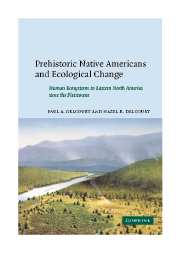 Prehistoric Native Americans and Ecological Change
Prehistoric Native Americans and Ecological Change Book contents
- Frontmatter
- Contents
- Acknowledgements
- PART I PANARCHY AS AN INTEGRATIVE PARADIGM
- PART II ECOLOGICAL FEEDBACKS AND PROCESSES
- 4 Gene-level interactions
- 5 Population-level interactions
- 6 Community-level interactions
- 7 Landscape-level interactions
- 8 Regional-level interactions
- PART III APPLICATION AND SYNTHESIS
- References
- Index
5 - Population-level interactions
Published online by Cambridge University Press: 30 October 2009
- Frontmatter
- Contents
- Acknowledgements
- PART I PANARCHY AS AN INTEGRATIVE PARADIGM
- PART II ECOLOGICAL FEEDBACKS AND PROCESSES
- 4 Gene-level interactions
- 5 Population-level interactions
- 6 Community-level interactions
- 7 Landscape-level interactions
- 8 Regional-level interactions
- PART III APPLICATION AND SYNTHESIS
- References
- Index
Summary
HUNTER–FORAGER ADAPTATIONS TO THE PLEISTOCENE/HOLOCENE TRANSITION
Changes in human subsistence patterns occurred in response to new opportunities presented by the change from Pleistocene to Holocene climate, vegetation, and fauna. By 11 500 BP, a foraging type of ecosystem type developed in which subsistence systems were becoming diversified, with a switch to white-tailed deer (Oedocoilus virginianus), moose (Alces alces), and woodland caribou (Rangifer tarandus) as primary prey animals in northern and eastern North America, and more intensive exploitation of local resources, including small game, nuts, fish, and shellfish that were previously not a major part of the prehistoric human diet (Stoltman and Baerreis, 1983). Because human populations had spread throughout North America, no new territories were left to colonize, and instead people developed localized technologies reflecting increasingly intensive use of local resources, including milling and nutting stones, steatite stone and ceramic containers, and fishing gear such as harpoon heads, net weights, and hooks. Social boundaries developed between group territories, and permanent communities were established (Stoltman and Baerreis, 1983).
Detecting the ecological interactions of prehistoric hunter–gatherers requires understanding the landscape context in which they interacted at the close of the last Ice Age (Yesner, 1996). One of the more important considerations is the size of the grain of habitats relative to the extent of the landscape occupied (Guthrie, 1984; Turner et al., 2001).
Spatially explicit models of settlement patterns
Spatially explicit models of settlement patterns relative to resource utilization are relevant to interpreting Paleoindian and Archaic period hunter–gatherer adaptations.
- Type
- Chapter
- Information
- Prehistoric Native Americans and Ecological ChangeHuman Ecosystems in Eastern North America since the Pleistocene, pp. 51 - 73Publisher: Cambridge University PressPrint publication year: 2004


